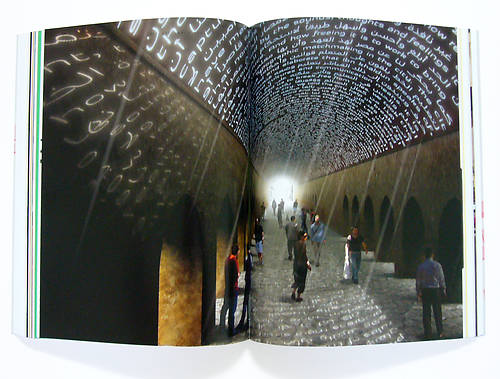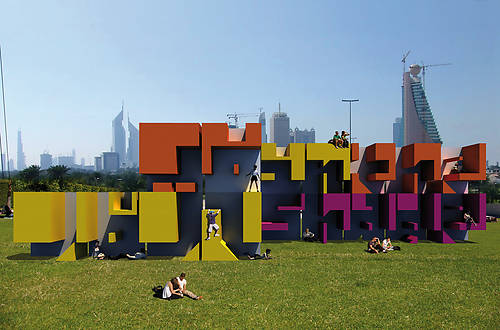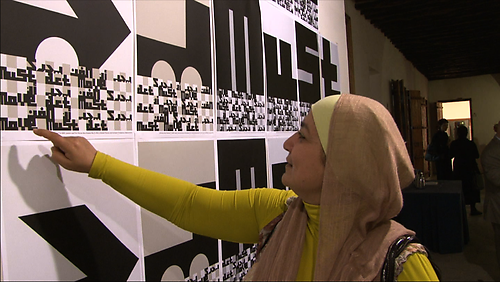My first discoveries
One of the first impressions I got of the Typographic Matchmaking, was an image of a huge three-dimensional shape with letters that I did not manage to read. However, I could sense meanings and my curiosity grew to decrypt this ‘unknown language’. The shape proved to be a mixture of both Latin and Arabic words, translating each other and forming a common text. As a matter of fact, it was a construction of the type font StoryLine, and one of the outcomes of the Typographic Matchmaking 2.0:
khtt.net
Naturally, I had discovered The Khatt Foundation – Center for Arabic Typography. Founded by Huda Smijtshuizen AbiFarès in 2004, this online platform offers a space for projects which develop Arabic typography and design, and deal with its relation to the Western society.
The project
The first initiative to the Typographic Matchmaking took place in 2005-07, the second in 2008-10. There is a lot to say about the project. The Typographic Matchmaking 1.0 deals with the typographic needs of contemporary design in the Arab world, specifically for publications and new-media. The Typographic Matchmaking 2.0 / in the City stretches the research into the urban space. Here, the focus is to bring the marriage between Arabic and Latin writing cultures to the three-dimensional city.
Huda Smijtshuizen AbiFarès introduces 15 professionals from Europe and the Middle East to collaborate in 5 teams. Each team consists of one Arab and one Dutch type/graphic designer and one architect or industrial designer. Each team also deals with a different subject. It is inspiring to me that they immediately move away from the original classical type and experiment with both language types, starting from scratch. The participants then visit respectively each other’s countries, and the cities of Amsterdam, Beirut and Dubai.
Backgrounds
I find it interesting to mention, that one of the reasons argued for the Typographic Matchmaking is, that because of the poor matches between the Arabic and Latin fonts, most bilingual design projects in the Middle East start in English before getting translated. Too often, the street sign you meet in the Middle East are written in a way that forces the Arabic language to adjust to the Latin language. The basic idea is thus to create new fonts that work both in Latin and Arabic, and especially to find types that create harmony between the different language structures. The aim of the project in the City, is also to bring back the sense of belonging to fast growing multicultural cities in the Arabic environment. One of the big challenges here, is how to deal with a visually already overcharged space. New alternative spaces within the contemporary, shopping dependent, urban structure may engage inhabitants on many levels and create a more emotional relationship with the direct environment and the larger world.
Another important reason is the demand for Arabic identity in the West. I could very well imagine that even people who do not speak Arabic, can connect to their roots through the presence of Arabic script.
Nuqat-folly, with poetry on its walls in the type font Nuqat:
Yielding outcomes
The Typographic Matchmaking is a merging of two cultures, where both adaptation and play are central. I was curious to see how two totally different kinds of languages can translate each other and at the same time meet each other’s ‘needs’.
The font named Nuqat is developed with a grid. The text is created out of dots in both language structures. The system of the grid has here the capacity of making a text where the letters are – or disconnected, or linked to each other. I find this font interesting for its apparent multiple possibilities. I also like to see how it could suit in different public spaces.
Here is a link to see some examples of the Nuqat used in several ways:
Among the different outcomes of each team, I was especially attracted by the most intriguing forms, in terms of readability. When looking at a written language that we do not understand, we are invited to explore what we see on a purely graphical level. I experienced this effect in different ways. What I find most interesting about the Typographic Matchmaking is that people are brought to deal with the written outcomes on a, maybe unconscious, very imaginative level, while at the same time being able to read the own language in the text.
Here under, developed by the team from PERFORMA, the triggering system of positive and negative spaces of StoryLine font, (or spread), in printed version:
While the StoryLine font divides the original languages into upper/lower halfs of letters, in order to make types, the Kashida font only deals with the aspects of continuity from caligraphy. What is special about the history of this outcome, is that even its starting point is mainly three-dimensional. I very much like that motion is involved; one has to turn the shape to make the two sides visible.
Also the Hamsa font, is resulting from a three-dimensional research. The lines are shaped from small paper try-outs, bent over wooden sticks. Personally, I find the following public space one of the most beautiful sites that came out of the Typographic Matchmaking in the City:

Conclusions, the book and the film
In all, I especially enjoy when, at first glance looking at these outcomes, I can ignore which line/side is Arabic and which is Latin text. At the same time I think a matchmaking as such, could be an inspiring method for educational use.
All the outcomes of the Typographic Matchmaking in the City are equally documented in a book: Typographic Matchmaking in the City – The Book
Last but not least, what touched me in this project is the immediate ‘dependency’ of the designers in relation to each other within the team. The Typographic Matchmaking can probably only leave the participants with a rich experience of cultural exchange. I found it very interesting to see them together in the collaboration process.
The film, a documentation by Jan de Bruin, is giving an idea of how they worked: Typographic Matchmaking in the City – The Film
///
[Khtt: The word means Writing, Calligraphy, Script and at the same time Line. It is easy to pronounce for a Western person, as ‘Khatt’.]
A personal view on the Typographic Matchmaking in the City, by Wael Morcos:
http://www.hamze.me
Presentation of the Typographical Matchmaking at Artsworld 2009:
http://www.youtube.com/watch?v=UIefPKIq-kc





